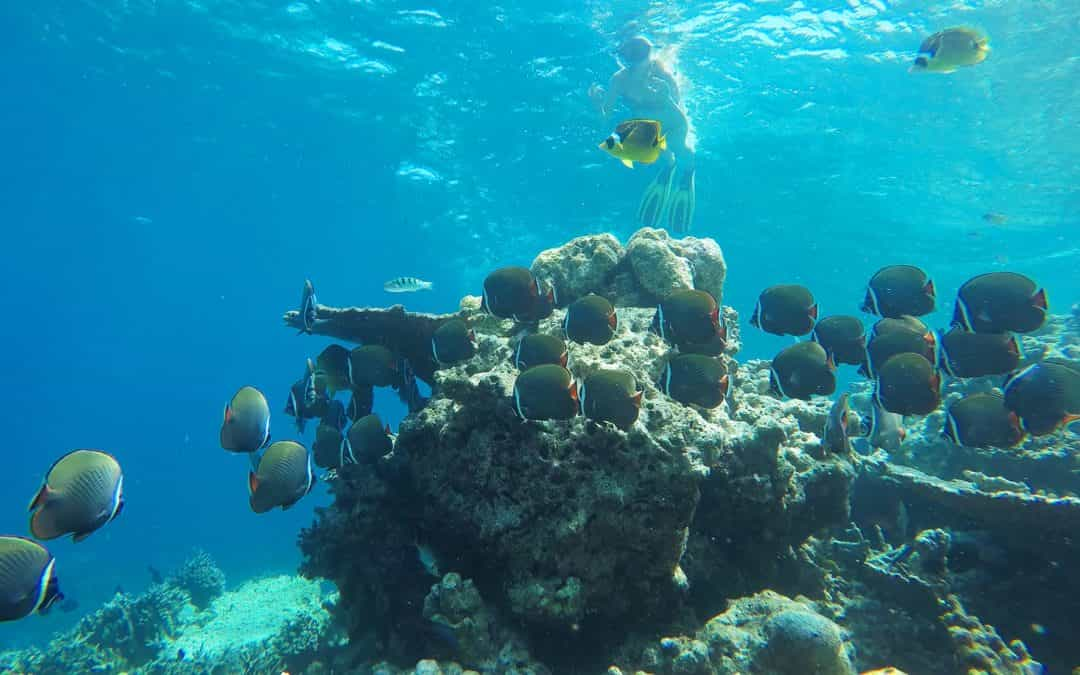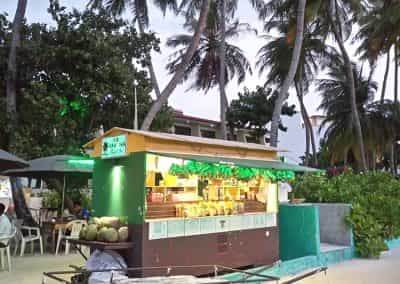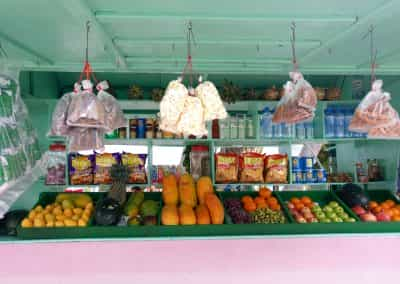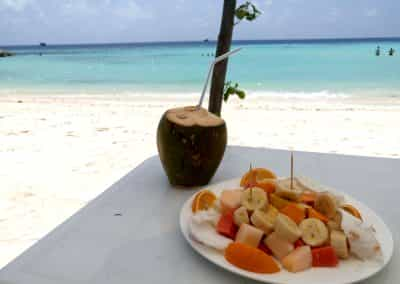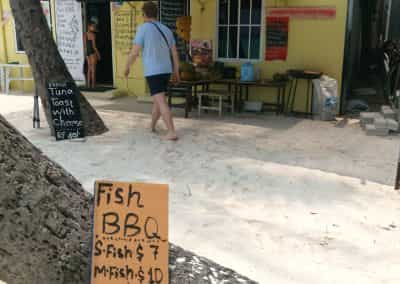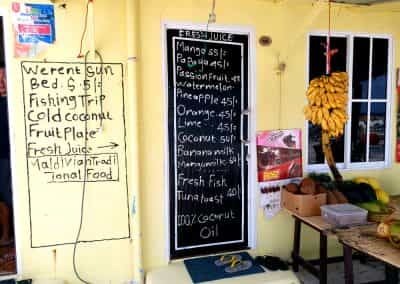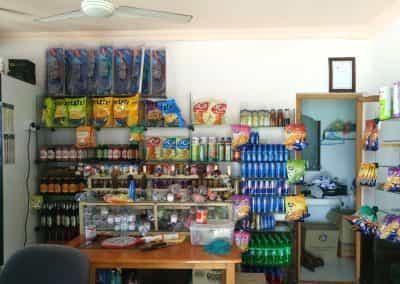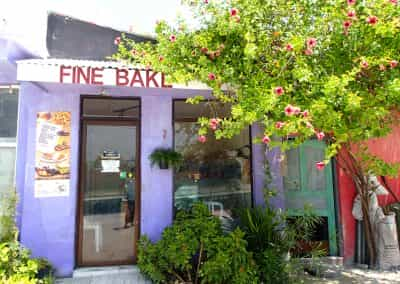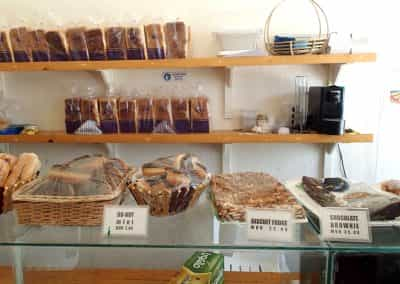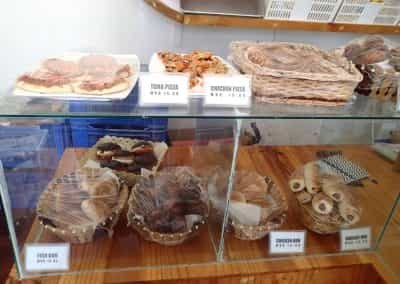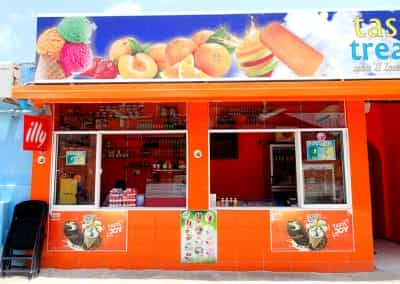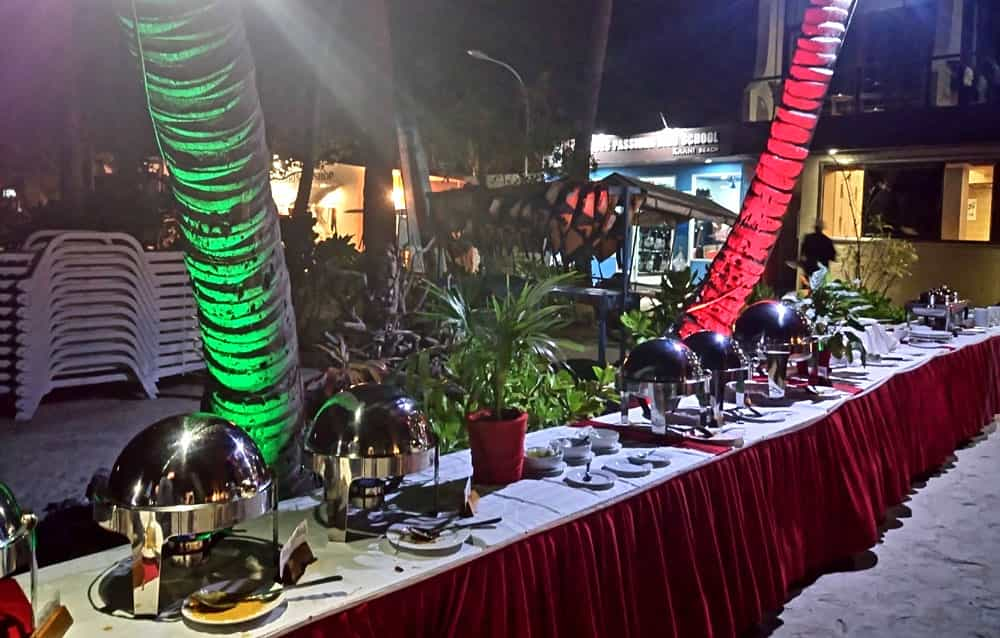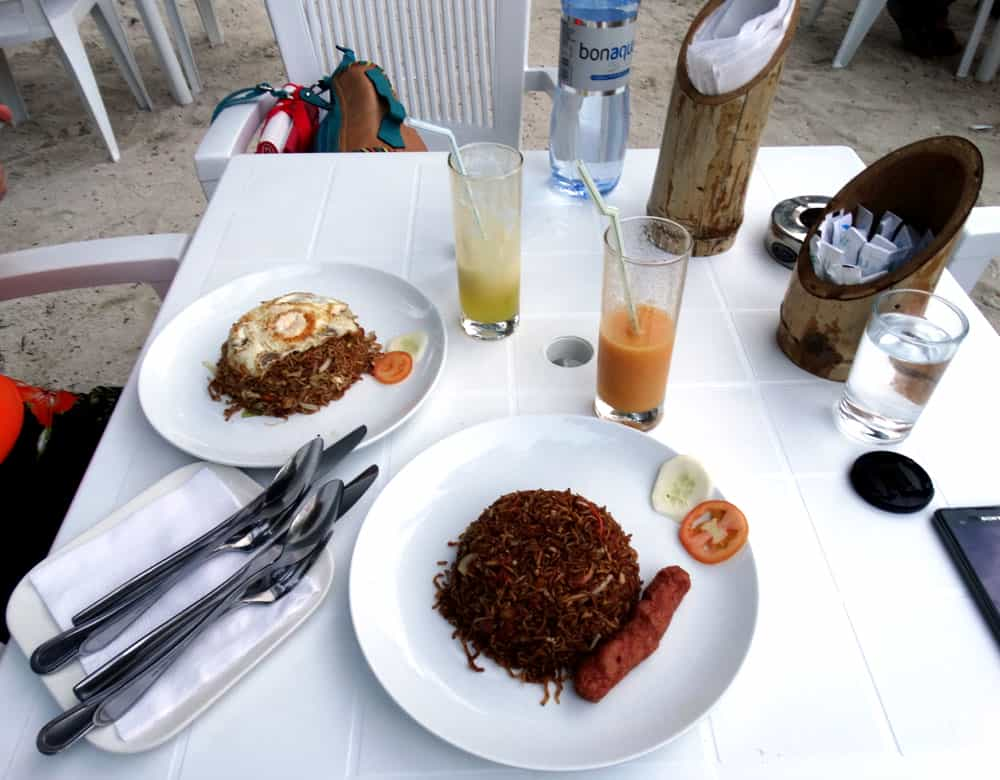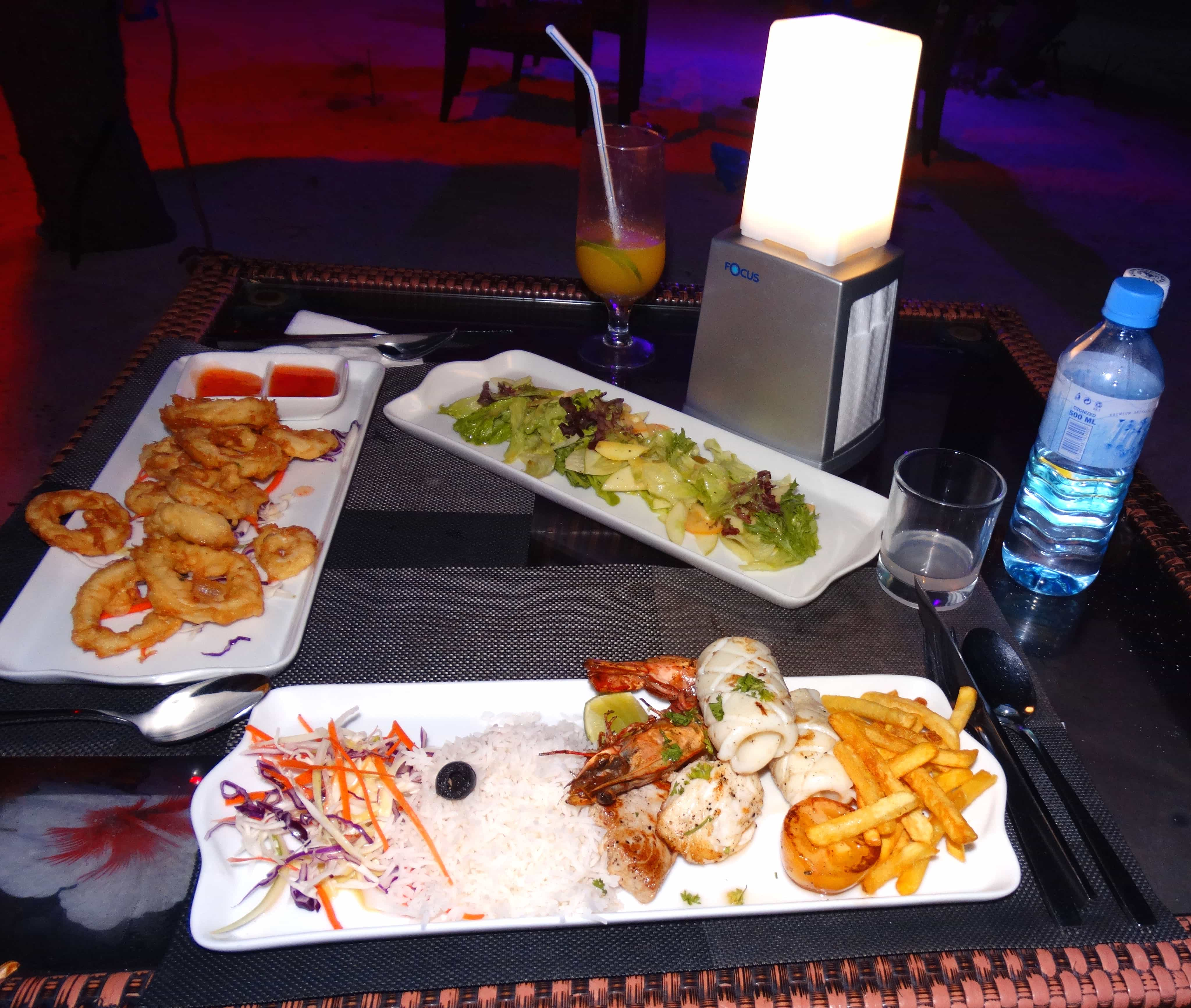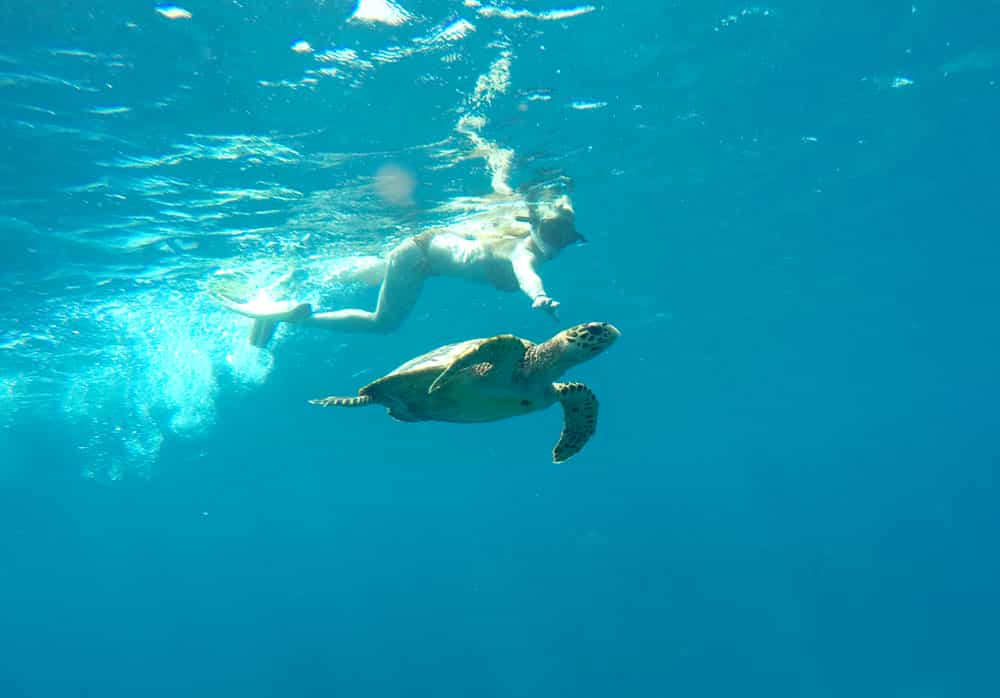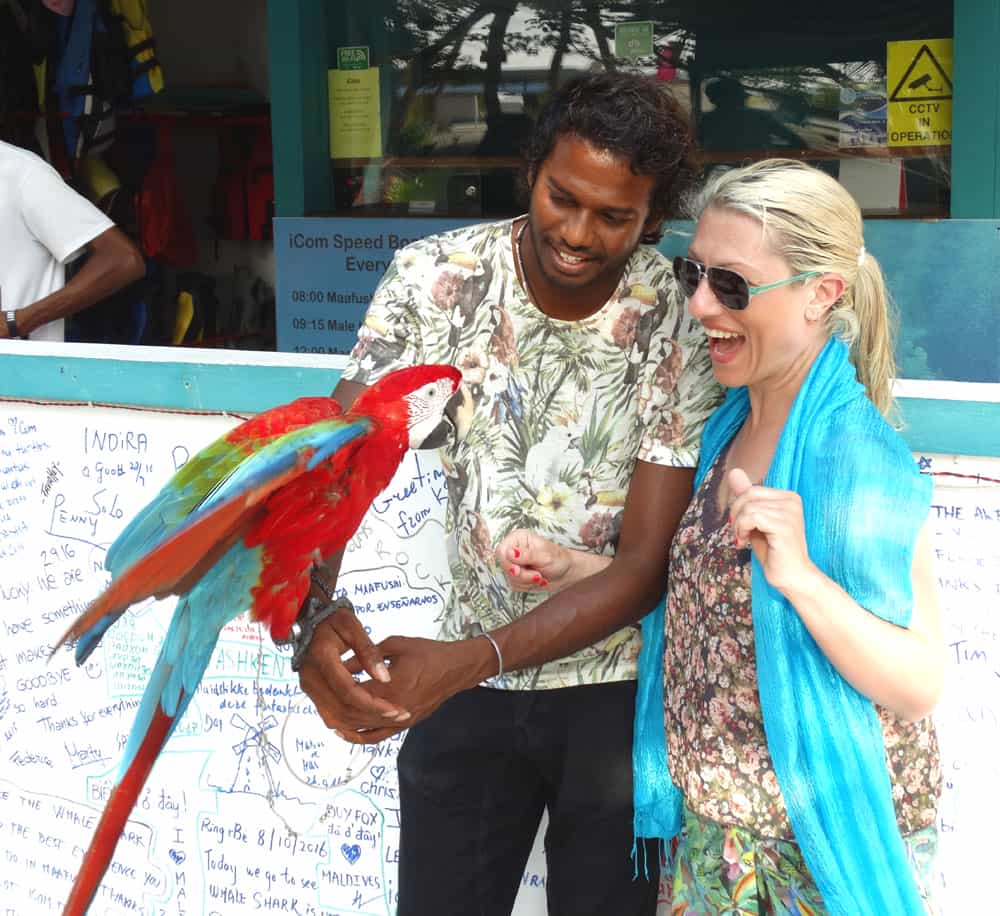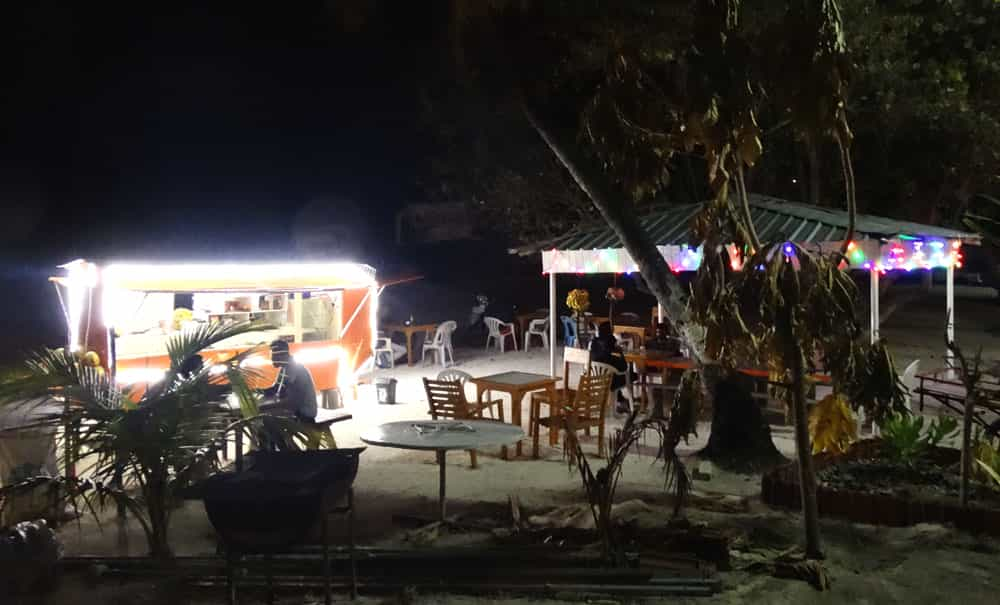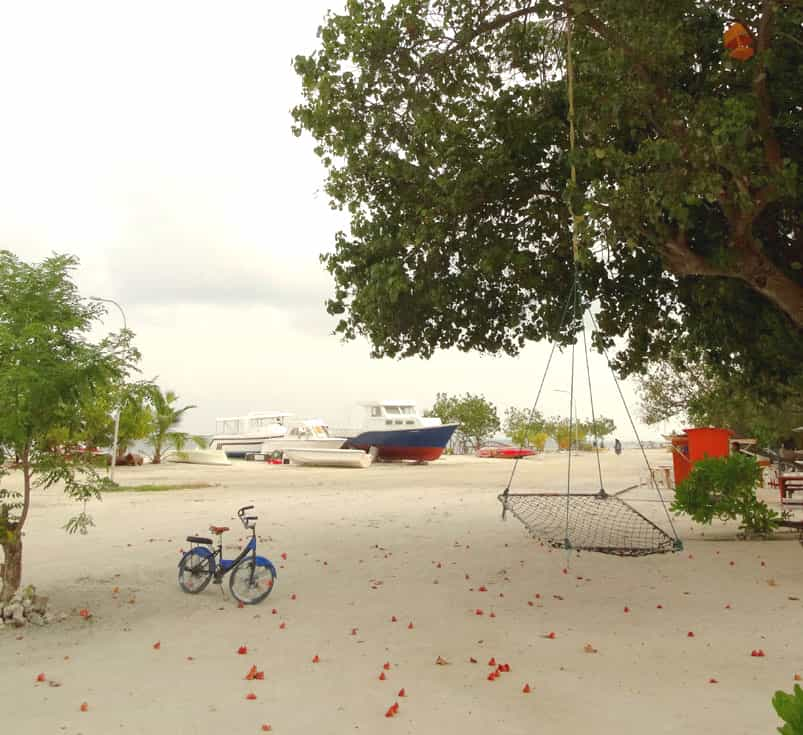Where to eat
There are multiple food options around the island. But there are NΟ alcohol options at ALL! The Maldives is a Muslim country, so the only places they serve alcohol are the luxury resorts. On a local island, you won’t be able to drink anything but juices, smoothies, coconut water, refreshments. Visitors prefer the hotel restaurants for lunch, where they offer mostly buffet-style dinner. You can also find some local restaurants in the village and at the port, mostly for local dishes, noodles, fresh fish, but also pizza, pasta and burgers. There are some food stalls around the island, where they sell refreshments, coconuts, fruits, dry nuts, potato chips, etc. at low prices. In the village you can find a local bakery selling bread, pies, desserts, such as some more shops selling ice-cream, coffee, etc. And of course you can buy whatever you want from their mini markets found across the village.
Pay attention to:
The closing times: Hotel restaurants close at about 22.00-22.30. If you haven’t had your dinner until then, bad for you! Only a few places running as “bars” close to the port stay open until late, but you’d better ask before you take a sit. The food stalls are the only shops staying open until midnight, but they don’t serve food.
Music: there are no music bars/restaurants in the island, so you should totally forget about the parties. Only some hotels offer live music to the clients during dinner time. We were told that there is a boat in the ocean playing music and serving alcohol, but we didn’t visit it. In general, the locals keep the island very quiet. There was a food stall outside “Isle Beach Inn” running until midnight. It was full of young locals every night during our stay, but they didn’t cause any noise at all. Generally, Maldivians are very calm people keeping a low profile; we never saw them fighting or yelling.
Drink only bottled water
Health: There is no risk of diseases in the Maldives. Depending on the season you may need mosquito repellent. We didn’t. Regarding food, we visited a lot of hotel restaurants and local ones. Everything was clean and we didn’t encounter any health/stomach problem. In case of an emergency, there is a hospital and a pharmacy in the center of the village, though. I visited it because I got burnt! A LOT! I always use sunscreen but during a snorkeling tour I was exposed to sun for lots of hours. I always use panthenol creme for sunburns, but I had forgotten to pack it with me. Unfortunately, I didn’t find it on the spot and used another one, so you’d better take yours from home.
Indicative food prices:
– Food stall: small bottle of water 0,15€ , coconut 2€
– Bikini beach: Small fruit salad 6€, big one 9€, fresh coconut 3€
– Arena hotel: Salad, sea food dish, fried squid dish, dessert, 2 refreshments: 41€ in total
– Kaani Beach hotel: 15$/person on a buffet style (incl: different kinds of salad, fishes, pasta, soups, desserts, chicken and water). Drinks are extra.
– Local restaurant close to the port: 2 dishes of noodles with chicken/seafood, 1 dish with chips, 1 dish of spring rolls, 2 fruit juices: 29€ in total
– Isle beach Inn: we ordered a special kind of fish a la carte on that day. 2 grilled reef fishes for each person, rice, salad, 2 refreshments: 39€ in total
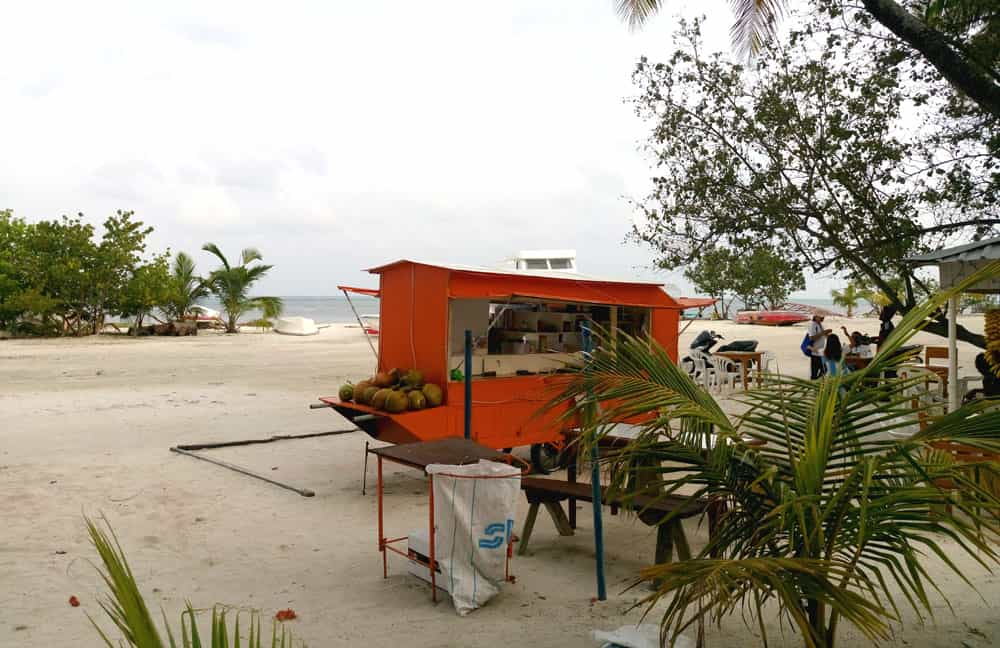
The food stall in front of our hotel at the public beach
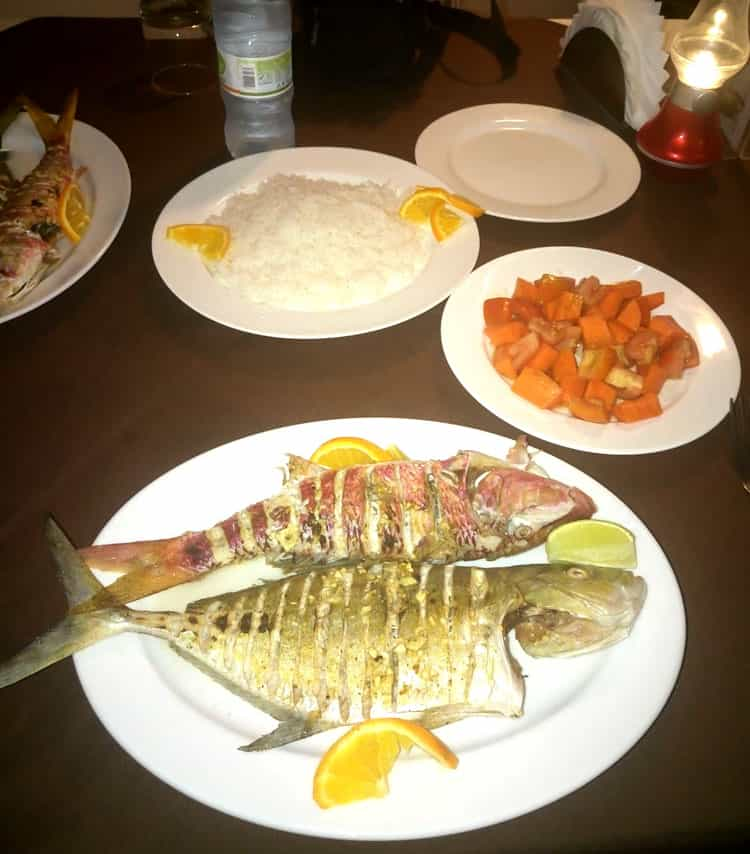
Dinner at Isle beach Inn, grilled fresh reef fishes with rice and salad
Lunch at a local restaurant: noodles with seafood/chicken
Top: Sea food dinner at Arena beach hotel
Left: Buffet style dinner at Kaani beach hotel
What to do
Not much to do on the island. Actually, there are not many things to do generally in the Maldives. If you are not a beach or sea lover, just don’t go! I honestly cannot put up with people who grumble that they have been there and got totally bored. Really, what did you expect? In these places you either relax at the beach all day long, or swim and do water sports. If you feel like sick and tired in 3 days, there’s nothing wrong with the place. You just made a wrong choice!
Maafushi is a small island having about 3.000 residents. You can walk around the place in just one day, explore the small streets of the village and the everyday life of the locals, their houses, mosques and culture. Or you can relax at the beach. Or you can book a snorkeling/diving tour to the amazing Indian coral reef to swim together with whale sharks, sea turtles and black-tip sharks. Additionally, you have the opportunity to visit some fancy resorts and spend a day in luxury. There are so many day tours to choose from. We used the ICom Tours (for our transfers from/to the airport, too) mostly for one snorkeling tour I was longing to book: the “Coral garden snorkeling tour”. This is a special tour of ICom Tours, suitable only for good swimmers. They transfer you to a secret place in the Indian Ocean reef, where you have the opportunity to swim for 2 hours without equipment (only fins and mask) together with black-tip sharks, sea turtles, eagle rays and countless colorful tropical fish!! A stunning experience indeed!
Additionally, we visited the amazing tropical paradise of the private Rihiveli island (picture above), where we spent a wonderful day in an eco resort together with sea turtles, big sting rays and tropical birds!
Top: Snorkeling tour to coral garden in Maafushi, swimming with black-tip sharks, eagle rays and turtles
Right: Outside the ICom Tours office with Ibrahim and the cute baby Kokky
Tips and advice:
- Currency: this is an issue in the Maldives. Their official currency is the Maldivial rufiyas (MVR), but they constantly use the American dollar in each transaction with tourists, and, that’s why I have already mentioned some prices in $. It doesn’t matter which country you come from, they always ask for $ and everything is more expensive than in their own currency. So, convert your currency into the local one and don’t deal with $ if you are not Americans (there is an official bank head office at the airport and in the village of Maafushi as well). You’d better have already exchanged some cash at the airport before your final destination, just in case.
- Tip: generally, they don’t ask for it. They are happy if someone gives them a tip, but they are not demanding or arrogant as in other countries. We usually leave a small tip to the bell boys and the restaurants. It is up to you.
- The island is totally safe. It is small and everyone knows each other. Anas, the guy from our hotel, told us that they sleep with their doors open. However, we have to take care of our personal belongings, just like everywhere else.
- The weather is totally unstable and the weather forecast totally unreliable. During the week we stayed there, the weather was forecasted to be stormy every day, the whole day. It rained only on our first night, twice, for half an hour and that’s it. So, do not pay much attention to the forecasts to book your trips. You’d better ask the locals, they know what the weather is going to be like the next day. Also, the use of a strong sunscreen, >50spf is absolutely necessary! Wherever you are sitting, whatever time of the day, in and out of the water, even if it is cloudy!
- Talk to locals. They are shy, but willing to help you in whatever you need, as long as you respect their religion and customs.
Locals at the food stall of the public beach
Relaxing on a Maldivian hammock of Isle Beach Inn
Maldivian people are Muslims, meaning:
a) the official bank holiday for the country is Friday (not Sunday). On that day, everything is closed, the local ferry is not running and the public beach is crowded all day long. It would be better for you to book a tour for that day.
b) no alcohol, no pork on the island
c) women have to be dressed in an appropriate way while walking around the island and especially within the village, covering parts of their body. Forget about bathing suits and short pants. They don’t force you to wear a scarf or a robe just like other Muslim counties, but it is better to wear a long dress, half-long sleeves or cover your shoulders and back with a scarf. I was usually wearing a blouse and a sarong during the day and a dress/pants with a nice scarf on my shoulders at night. Same for the public beach (as I mentioned before). We ought to respect the customs and rules of each place we visit, especially if they don’t insult us. And I believe that the locals are very tolerant here, as some tourists unfortunately behave sometimes disrespectfully.
d) they always take off their shoes when entering a room. We saw that even in a super market. Follow their example and leave your shoes, flip-flops etc outside.
To sum up, is it actually the Maldives a budget-friendly destination?
To tell you the truth, I was expecting to find better prices everywhere. The food is quite expensive, costs as much as in Europe. I had read in an old post that lobsters are cheap enough, but actually they cost as much as in a Greek island (60€). Generally, the north part of the island is more expensive than the south, because of high tourism. We even found different prices in the super markets. The cost of everything in the Bikini beach is quite high. Even the tours are more expensive here than other tropical places.
However, the Maldives has been a great affordable destination for the budget traveler and everyone can now afford the expenses for one week if he decides to stay at a local island.

